

From it’s likely beginnings in bats, to global vaccine research using llamas, to scientists’ daily discoveries about the virus’s behavior, to the death toll, much about Covid-19 seems overwhelming.
But, having experienced the stay-at-home order, we do now understand the basic principles of pandemic control.
Despite Americans’ inclination to resist government intervention in their lives, Denver residents showed they understood exponential growth and flattening the curve—and they did it. The number of new Covid-19 cases has been trending down since the April 23 peak of 177 cases. On May 21 it was 64 new cases.

Hospitalizations peaked on March 31 with 19 non-ICU admissions and 13 ICU and has also trended down since then. May 20 saw 6 non-ICU and 2 ICU admissions.
Now, despite being one of the fastest growing cities in the country, Denver’s success controlling Covid relies on the basic small town principle, “I’ll help you—and thank you for helping me.”
When we go out, we may see the “old normal”—cars on the roads (with our view of the mountains getting hazy again) and people on the sidewalks. But now, when our path crosses that of a fellow shopper in the grocery store, we’re thinking, “I’m relying on you for my health.” That person’s mask and physical distancing are comforting signs that they’re likely participating in the “new normal” in other ways, too: washing hands often, trying not to touch their face, avoiding crowds, and isolating themselves when they have any sign of illness.
https://intake-app-dot-cdphe-erm.appspot.com/intake-form
In the “new normal,” the Symptom Tracker App gives public health experts early information about illness in the community AND it provides users with advice and information.
When a person starts having any of the symptoms associated with Covid-19, even mild ones, the public health department encourages use of their app for sharing symptoms. Users can also participate in the text messaging option that will send them a daily text asking how they are doing and pointing them to additional resources. “It gives us a bigger picture overall of illness in the in the community,” says Alicia Cronquist, an epidemiologist with the Colorado Department of Public Health and Environment (CDPHE). “It’s an opportunity for public health and community members to interact before the testing occurs.” She says every field is optional and the information is confidential, shared only with the local public health agency where the person resides
 “Hearing about people when they have symptoms before testing, or before they have a positive test, can help us give them important information to get them into isolation. The nurse can give them some guidance about what they need to do. But also, public health learns about potential cases a few days before we might otherwise know about them,” says Cronquist. “It doesn’t answer the question about people with no symptoms at all possibly being contagious, but it provides information to people when they’re feeling something, but not sure they’re sick enough to go to the doctor or get testing.”
“Hearing about people when they have symptoms before testing, or before they have a positive test, can help us give them important information to get them into isolation. The nurse can give them some guidance about what they need to do. But also, public health learns about potential cases a few days before we might otherwise know about them,” says Cronquist. “It doesn’t answer the question about people with no symptoms at all possibly being contagious, but it provides information to people when they’re feeling something, but not sure they’re sick enough to go to the doctor or get testing.”
The Symptom Tracker also asks app users about other diagnosed medical conditions. The responses from 265 Denverites through May 22 were:
- Weak immune system 10.9%
- Lung disease 5.7%
- Diabetes 4.5%
- Heart Disease 2.3%
For more information visit https://covid19.colorado.gov/covid19-symptoms. To report symptoms visit https://intake-app-dot-cdphe-erm.appspot.com/intake-form
 How are outbreaks handled?
How are outbreaks handled?
If a facility identifies two or more Covid-19 cases with onset in a 14-day period, the facility will temporarily close and contact Public Health for cleaning, mitigation, employee screening, and reopening guidance. (CDPHE’s 12-page Workplace Outbreak Guidance document is linked to this article at FrontPorchNE.com.)
We specifically asked the CDPHE media information center to respond to concerns about grocery store outbreaks as shown in the above graphic. Their response: “People have several choices about HOW they get their groceries with options that do not require entering the store if that is what they want; outbreaks there are cause for concern for everyone.”
What about issues with those who don’t wear a face covering?
We asked CDPHE to respond to ongoing concerns about grocery shoppers not wearing face coverings. We received this response by email: “People who do not wish to wear masks or who can not wear masks due to medical reasons are encouraged to use delivery, curbside pickup or drive-through options.
“Challenging these safety measures threatens to undo the monumental effort that our state has undertaken to limit the spread of the virus and could put others in danger. If someone is being confrontational in refusing to follow safety measures at a business, we encourage you to call law enforcement to help de-escalate the situation rather than attempting to remove the person or continue the confrontation. Officers are trained to respond to tense situations and to keep the public safe. No one should take the law into their own hands.
“Continued urging of a masked culture by everyone is the best strategy for volunteer compliance. Local public safety is best suited to address these issues as they arise.”
What are the goals of Colorado’s mitigation strategy?
- Slow down virus spread so we don’t exceed hospital capacity
- Get kids back to school in the fall
- Prevent a second wave, especially during the
peak flu season (Nov–March) - Prevent having to return to Stay-at-Home

Source: Colorado School of Public Health
What is the projected outcome of Colorado’s mitigation measures?
Colorado’s strategy for controlling Covid so it won’t overwhelm the medical system is based on maintaining social distancing at 55% relative to pre-Covid normal. The projections for the number of ICU beds needed vary as shown below if social distancing (SD) is practiced more or less rigorously.
The model below assumes ALL of the following occur in addition to social distancing:
- Everyone over 2 years wears a mask in public
- Older adults stay home
- Symptomatic people are isolated
(information from Colorado Joint Information Center)
Click here for the CDPHE COVID-19 Preventing, Reporting and Mitigating Workplace and Non-Health Care Non-Residential Facility Outbreaks
Sources:
—The bat photo is from iStockPhoto
—Denver Cases and Hospitalizations charts are from Denver Public Health Covid-19 Data Summary
—Symptom Tracker App graphic is from CDPHE
—Body Symptoms graphic by Front Porch with Denver data from the Symptom Tracker App
—Colorado Outbreaks and ICU Beds Needed are from Colorado Joint Information Center—Photo of Winter the llama is courtesy of the University of Texas
Llama Research Could Lead to Covid-19 Treatment
 Research on possible treatments for Covid-19 is taking many forms—one of them is examining llama antibodies. In 2016, a research team studying prior coronavirus outbreaks (SARS and MERS)1 learned that “spike proteins” found on the surface of coronaviruses latch onto and fuse with the host’s cells and can then reproduce the virus in the host.
Research on possible treatments for Covid-19 is taking many forms—one of them is examining llama antibodies. In 2016, a research team studying prior coronavirus outbreaks (SARS and MERS)1 learned that “spike proteins” found on the surface of coronaviruses latch onto and fuse with the host’s cells and can then reproduce the virus in the host.
These researchers discovered that llamas produce specific antibodies (different from humans) called nanobodies, and they injected Winter the llama with spike proteins from the SARS and MERS viruses. Nanobodies were subsequently harvested from the llama’s bloodstream and produced in the lab. Those nanobodies successfully prevented the viruses from entering cells.
With the arrival of the pandemic, the researchers tested whether any of the nanobodies they had developed for SARS and MERS could also stop the Covid-19 virus from infecting cells. Their original nanobodies were not successful, but they were able to engineer one partially successful nanobody so that it was able to stop the Covid-19 virus from entering cells in laboratory experiments.
After future experiments on animals, the researchers hope to do human trials and develop a treatment for people already infected or at high risk of becoming infected with Covid-19.
1 Daniel Wrapp and Dr. Jason McLellan from the University of Texas, in collaboration with a Belgian research team.



Thank you for the great article. Will you share this article with me in a format that I can easily print (e.g., 1 or 2 pages w/ the story, photos and graphs but not the advertisements, etc.) for my grandchildren’s scrapbook? I am documenting this crazy time in their/our lives.